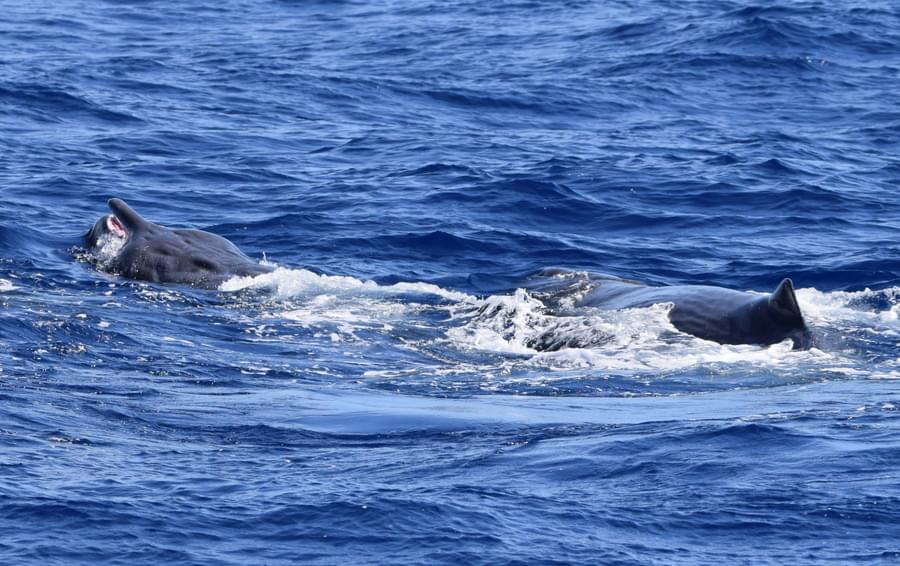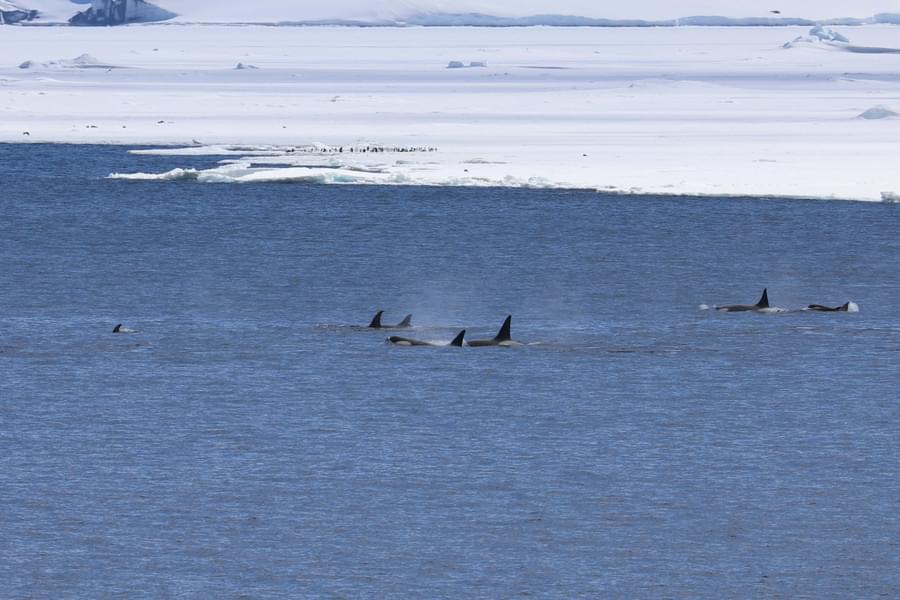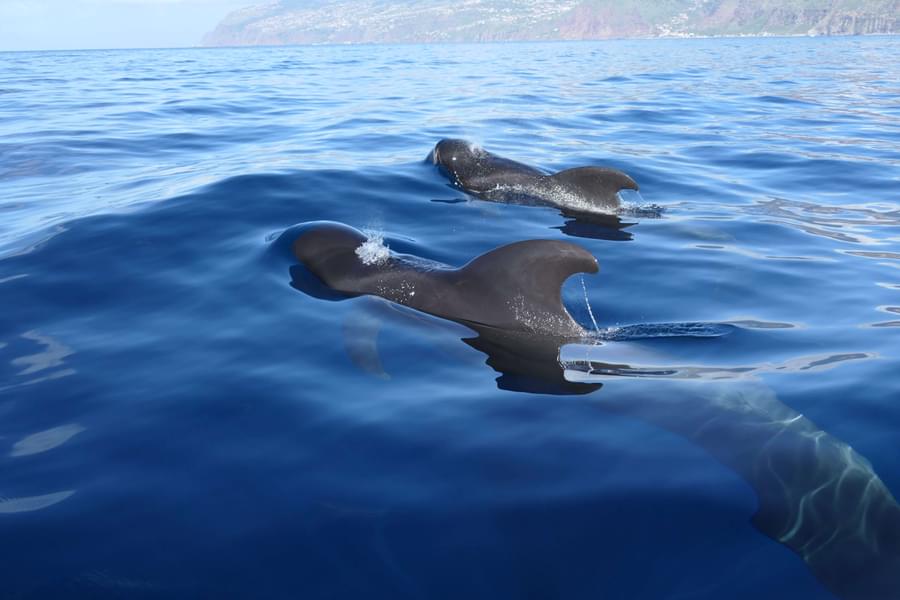March 8th marks International Women’s Day, a global day that celebrates the social, economic, cultural and political achievements of women worldwide. Our recent Ocean Conservationist graduate Gemma takes a deeper look into the role of females in cetacean societies across a few different species and sees what we can learn from these majestic marine matriarchs!
Sperm whale (Physeter macrocephalus)

For many cetacean species, social groups are strongly organised based around female kinship (1). Females have a crucial and often central role in cetacean society (particularly in toothed whales) from coordinating group behaviours to guiding others. Sperm whales live in complex sexually segregated social structures known as units, which consist of females and offspring that are often (but not always) related (1,2). These units vary in size, typically ranging from around 6 to 12 individuals and most females remain with their unit for their entire lives, whilst males disperse after reaching maturity and remain mostly solitary or form bachelor groups (3). Sperm whales communicate with each other using vocalisations known as codas, which consist of a distinctive series of clicks. These vocalisations are very different from the clicks used for hunting and navigation (echolocation). Codas are so complex that research has suggested they share similarities with human vowels! (4). Different social units have distinctive vocal repertoires (dialects) that are culturally learnt, which governs interactions between sperm whale units, with those sharing the same vocal dialect preferring to socialise together (3,5).
Sperm whales have been known to group together in tight formations to defend the family unit from killer whales/orcas (Orcinus orca) and individuals have been observed risking their lives to protect other members of the unit (6). Groups of females have been shown to make democratic group decisions when deciding which direction to turn in, sometimes taking an hour or longer to decide which way to go (7). Females and their young are very social, and females communally raise and nurse each other’s calves (7). Calves can’t (or won’t) dive to the great depths that adults can, so they have to stay close to the surface whilst their mothers catch prey. Whilst mum is hunting squid in the depths, other members of the unit will stay with the calf to babysit and keep it safe. In a rarely seen event last year, researchers at Project CETI witnessed the birth of a sperm whale and filmed the family unit grouping together to lift the baby above the water so it could breathe, and they helped to carry the newborn for hours! During this event, bioacoustic research revealed that the sperm whales were silent until the calf was born and then there was an eruption of vocalisations-as if they were welcoming the new calf into the world!
Killer whale / orca (Orcinus orca)

Orca, or killer whales, are an iconic species known to live in pods which are close-knit family units with complex social dynamics. Social structures and pod sizes vary considerably across ecotypes and dynamics are strongly influenced by female kinship (1). In the southern resident killer whale population, female and male offspring stay with their mother for life (which is very rarely seen in mammals!). Grandmothers play a vital role as sources of wisdom from which the rest of the family learns crucial survival behaviours, and it is an older matriarch who leads and guides the pod (8). Females are important in contributing to the survival of younger members of the pods (9) by passing on cultural behaviour and traditions such as specialised hunting strategies and distinctive vocal dialects to younger generations. Killer whales communicate using a range of clicks, whistles and burst pulse sounds, and also have culturally learned dialects and prefer to interact with those sharing similar dialects.
Female killer whales tend to live longer than males (up to 90 years in the wild, possibly longer!) and they accumulate a wealth of vital knowledge over their lifetime, like remembering important locations and timings for finding prey (8). Research on the endangered southern resident killer whales has shown that in times when prey is scarce, it is the older females that lead the way to help locate prey (8). Elder female killer whales help younger members of the family to learn and perfect highly complex and sometimes risky hunting techniques. Some killer whale ecotypes learn the high-risk method of hunting in the shallows and intentionally strand themselves on the shore to catch sea lion pups off the coast of Argentina (10), while others learn how to locate and cooperatively wash seals off ice floes in Antarctica (read more about Antarctic killer whale ecotypes here). These specialist methods of hunting take years of practice to learn, and the impressive knowledge and leadership of elder females helps young killer whales to acquire vital survival skills over time.
Pilot whale (Globicephala spp)

Both species of pilot whale (short-finned and long-finned) live in complex, multigenerational social units consisting of up to around 30 whales, including a mixture of both sexes, but typically more females than males. Pilot whales are highly social and share strong, long-term relationships with others within the unit. Pilot whales don’t just socialise with anyone though, they have been known to have favourite companions they associate with the most frequently (11) and casual acquaintances (12,13). Different social units regularly gather to form temporary, much larger groups of anything from 80 to 100 or more animals. These larger groups are comprised of several different matrilines (maternally related individuals descending from a single ancestral female) and distant relatives (1). Research has shown that in some populations, such as in the Strait of Gibraltar, social units will congregate, and the pilot whales will actively search for their favourite companion (14), which highlights the strength of their bonds!
From research carried out so far, it is thought that pilot whales live in social structures with dynamics between those seen in sperm whales and killer whales. Pilot whales exhibit similarities to these species, such as having stable matrilineal (maternally related) social units, but they also display more fluid associations (15). It is thought that neither the female nor male offspring leave the family unit, other than temporarily for mating purposes. This behaviour is very unusual among mammals, as typically one of the sexes will disperse after reaching maturity (1,12,13). There has also been research showing that pilot whale calves interact regularly with adult females aside from their mothers both within and outside of their family unit, which could suggest that alloparental care (shared parental care) occurs, although more research is needed to confirm this (1). Mass strandings of pilot whales are thought to be linked to these strong social bonds.
Sociality and conservation
These incredible species highlight the complexities of cetacean behaviour, and the importance of social relationships in structuring populations. There are many other species with complex social structures, such as bottlenose dolphins (Tursiops spp), beluga whales (Delphinapterus leucas) and narwhals (Monodon monoceros), to name a few. However, many cetaceans remain data deficient and are challenging to study, so the social structures remain largely unknown for many species. Continued research is needed to enhance our understanding of cetacean social behaviours, as this will enable us to develop strategies to protect them and preserve their social dynamics. Extreme and sudden changes to social structure are very rare in nature and usually only occur as the result of events such as hurricanes forcibly separating families and deaths of individuals (15). Removal of key individuals from a population could seriously disrupt the intricate social dynamics in cetacean societies, which could have a ripple effect on the rest of the family and, ultimately, the entire social network. We must safeguard cetacean social structures or risk disrupting their bonds, extinguishing their culture and jeopardising their long-term survival outcomes.
There are so many ways you can help us to protect these highly sentient and intelligent animals. You can join us by training as a Marine Mammal Surveyor and help us to collect vital data. Or you can become a member and hear regular updates about our work.
References
Rendell, L., Cantor, M., Gero, S., Whitehead, H. and Mann, J., 2019. Causes and consequences of female centrality in cetacean societies. Philosophical Transactions of the Royal Society B, 374(1780), p.20180066.
Gero, S., Milligan, M., Rinaldi, C., Francis, P., Gordon, J., Carlson, C., Steffen, A., Tyack, P., Evans, P. and Whitehead, H., 2014. Behavior and social structure of the sperm whales of Dominica, West Indies. Marine Mammal Science, 30(3), pp.905-922.
Vachon, F., Hersh, T.A., Rendell, L., Gero, S. and Whitehead, H., 2022. Ocean nomads or island specialists? Culturally driven habitat partitioning contrasts in scale between geographically isolated sperm whale populations. Royal Society Open Science, 9(5), p.211737.
Beguš, G., Sprouse, R.L., Leban, A. and Gero, S., 2023. Vowels and Diphthongs in Sperm Whales.
Whitehead, H., Antunes, R., Gero, S., Wong, S.N., Engelhaupt, D. and Rendell, L., 2012. Multilevel societies of female sperm whales (Physeter macrocephalus) in the Atlantic and Pacific: why are they so different? International Journal of Primatology, 33, pp.1142-1164.
Pitman, R.L., Ballance, L.T., Mesnick, S.I. and Chivers, S.J., 2001. Killer whale predation on sperm whales: observations and implications. Marine mammal science, 17(3), pp.494-507.
Whitehead, H., 2024. Sperm whale clans and human societies. Royal Society Open Science, 11(1), p.231353.
Brent, L.J., Franks, D.W., Foster, E.A., Balcomb, K.C., Cant, M.A. and Croft, D.P., 2015. Ecological knowledge, leadership, and the evolution of menopause in killer whales. Current biology, 25(6), pp.746-750.
Nattrass, S., Croft, D.P., Ellis, S., Cant, M.A., Weiss, M.N., Wright, B.M., Stredulinsky, E., Doniol-Valcroze, T., Ford, J.K., Balcomb, K.C. and Franks, D.W., 2019. Postreproductive killer whale grandmothers improve the survival of their grandoffspring. Proceedings of the National Academy of Sciences, 116(52), pp.26669-26673.
Hoelzel, A.R., 1991. Killer Whale Predation on Marine Mammals at Punta Norte, Argentina; Food Sharing, Provisioning and Foraging Strategy. Behavioral Ecology and Sociobiology, pp.197-204.
Mahaffy, S.D., Baird, R.W., McSweeney, D.J., Webster, D.L. and Schorr, G.S., 2015. High site fidelity, strong associations, and long‐term bonds: Short‐finned pilot whales off the island of Hawai ‘i. Marine Mammal Science, 31(4), pp.1427-1451.
De Stephanis, R., Verborgh, P., Pérez, S., Esteban, R., Minvielle-Sebastia, L. and Guinet, C., 2008. Long-term social structure of long-finned pilot whales (Globicephala melas) in the Strait of Gibraltar. Acta Ethologica, 11, pp.81-94.
Ottensmeyer, C.A. and Whitehead, H., 2003. Behavioural evidence for social units in long-finned pilot whales. Canadian Journal of Zoology, 81(8), pp.1327-1338.
Senigaglia, V., de Stephanis, R., Verborgh, P. and Lusseau, D., 2012. The role of synchronized swimming as affiliative and anti-predatory behavior in long-finned pilot whales. Behavioural processes, 91(1), pp.8-14.
Esteban, R., Verborgh, P. and Freitas, L., 2022. Dynamics of short-finned pilot whales long-term social structure in Madeira. Mammalian Biology, 102(4), pp.1315-1332.

